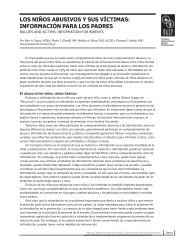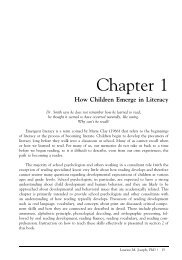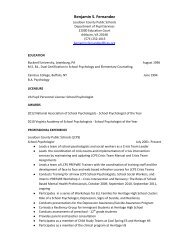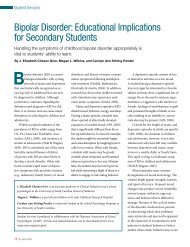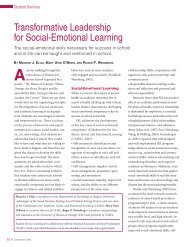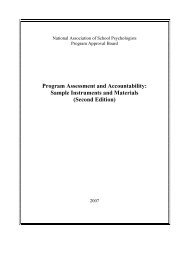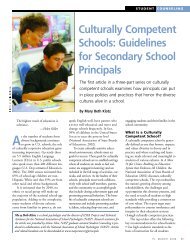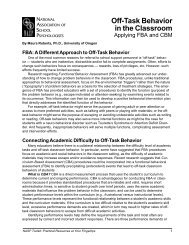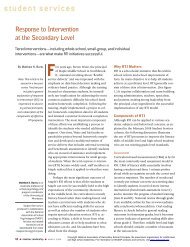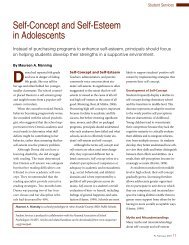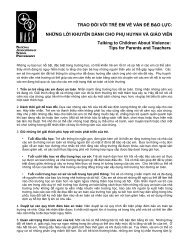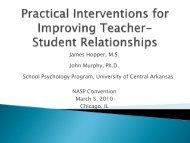Best Practices in Play Assessment and Intervention
Best Practices in Play Assessment and Intervention
Best Practices in Play Assessment and Intervention
Create successful ePaper yourself
Turn your PDF publications into a flip-book with our unique Google optimized e-Paper software.
<strong>Best</strong> <strong>Practices</strong> <strong>in</strong> School Psychology V<br />
tiers by describ<strong>in</strong>g how play assessment <strong>and</strong> <strong>in</strong>tervention<br />
can be used <strong>in</strong> early <strong>in</strong>tervention services.<br />
Case 1<br />
Ms. Austen, a mother of three young children, contacted<br />
Spr<strong>in</strong>gfield Elementary School to f<strong>in</strong>d out more about<br />
child development <strong>and</strong>, more specifically, whether her<br />
children were on the appropriate developmental<br />
trajectory. Ms. Austen then met with the school<br />
psychologist who served Spr<strong>in</strong>gfield Elementary. She<br />
stated that her ma<strong>in</strong> concern was whether she was<br />
provid<strong>in</strong>g the appropriate learn<strong>in</strong>g environment for her<br />
children to develop necessary skills <strong>and</strong> be ready for<br />
k<strong>in</strong>dergarten. The school psychologist suggested that, by<br />
watch<strong>in</strong>g her children play, Ms. Austen could learn<br />
about how her children were function<strong>in</strong>g. She was asked<br />
to keep a record of the type of play that her children<br />
frequently engaged <strong>in</strong> as well as any newly emerg<strong>in</strong>g<br />
play activities. One month later, she returned to the<br />
school to share her observations with the school<br />
psychologist. The PIECES cod<strong>in</strong>g scheme was discussed<br />
with Ms. Aust<strong>in</strong> <strong>and</strong> compared to her observations (see<br />
Table 3), at which time it was determ<strong>in</strong>ed that the<br />
children were function<strong>in</strong>g with<strong>in</strong> the normal range. This<br />
reassured her that she was provid<strong>in</strong>g appropriate<br />
activities. The session concluded with the school<br />
psychologist giv<strong>in</strong>g Ms. Austen a h<strong>and</strong>out that listed<br />
developmentally appropriate activities that she could do<br />
at home with the children.<br />
Case 2<br />
Ms. Jenn<strong>in</strong>gs visited the pediatrician for her 3-yearold<br />
son Jeremy’s annual exam<strong>in</strong>ation. Dur<strong>in</strong>g the<br />
appo<strong>in</strong>tment the pediatrician <strong>in</strong>terviewed Ms.<br />
Jenn<strong>in</strong>gs, who had concerns that her child might not<br />
be demonstrat<strong>in</strong>g age-appropriate cognitive skills. The<br />
pediatrician gave Ms. Jenn<strong>in</strong>gs pamphlets on typical<br />
developmental milestones for 3-year-olds <strong>and</strong> referred<br />
her to the school district for screen<strong>in</strong>g. Ms. Jenn<strong>in</strong>gs<br />
contacted the school, <strong>and</strong> the early childhood consultant<br />
went to the house to conduct a screen<strong>in</strong>g of Jeremy.<br />
This screen<strong>in</strong>g consisted of an observation of Jeremy<br />
dur<strong>in</strong>g 30 m<strong>in</strong>utes of free play followed by an <strong>in</strong>terview<br />
with Ms. Jenn<strong>in</strong>gs. The early childhood consultant<br />
determ<strong>in</strong>ed that Jeremy’s pretend play was below the<br />
expected level <strong>and</strong> the consultant referred him to the<br />
early childhood school psychologist. The school psychologist<br />
conducted a more thorough play assessment of<br />
Jeremy <strong>in</strong> his preschool <strong>and</strong> then classified his behaviors<br />
us<strong>in</strong>g the PIECES cod<strong>in</strong>g scheme. In total, the play<br />
behaviors observed <strong>in</strong> the preschool were consistent with<br />
both how Ms. Jenn<strong>in</strong>gs reported that Jeremy plays at<br />
home <strong>and</strong> what the early childhood<br />
practitioner reported see<strong>in</strong>g <strong>in</strong> the <strong>in</strong>itial play<br />
assessment.<br />
In the exploratory/pretend play subdoma<strong>in</strong>, Jeremy’s<br />
skills were predom<strong>in</strong>antly at the level of simple s<strong>in</strong>gle<br />
behavior pretend play acts. An example of this type of<br />
play was when Jeremy pretended to eat a cookie <strong>and</strong><br />
then had his teacher pretend to eat the cookie. Active<br />
other-directed acts were emerg<strong>in</strong>g but less common,<br />
<strong>in</strong>dicat<strong>in</strong>g skills at the 24-month level. Jeremy demonstrated<br />
this skill when he was play<strong>in</strong>g with a toy dog <strong>and</strong><br />
made it bark. In contrast, age-appropriate pretend play<br />
at Jeremy’s age should have <strong>in</strong>volved short sequences of<br />
three pretend play acts such as mak<strong>in</strong>g the dog bark,<br />
Table 3. Examples of Ms. Austen’s Descriptions of Her Children’s <strong>Play</strong> <strong>and</strong> Correspond<strong>in</strong>g PIECES<br />
Codes<br />
Children Mother’s description PIECES subdoma<strong>in</strong> <strong>and</strong> level<br />
Brady<br />
(4 months)<br />
Elliot<br />
(28 months)<br />
Lydia<br />
(51 months)<br />
. <strong>Play</strong>s with feet <strong>and</strong> chews on toes . Exploratory/pretend play: mouth<strong>in</strong>g<br />
. Bats at toys . Exploratory/pretend play: simple manipulation<br />
. Grabs toys/anyth<strong>in</strong>g <strong>and</strong> puts them <strong>in</strong> his mouth . Exploratory/pretend play: mouth<strong>in</strong>g<br />
. Makes snakes with <strong>Play</strong>-Doh; slithers them around<br />
<strong>and</strong> says ‘‘sssss’’<br />
. Exploratory/pretend play: active other-directed act<br />
. Counts to 14 . Quantification skills: counts to 5+<br />
. Pretends to be a cat; crawls around <strong>and</strong> meows . Exploratory/pretend play: self-directed act<br />
. Puts on sunglasses, grabs a bag, <strong>and</strong> says, ‘‘Bye Mommy,<br />
I go work.’’<br />
. Exploratory/pretend play: multischeme comb<strong>in</strong>ation<br />
. L<strong>in</strong>es up toy cars by size . Categorization: sorts objects by size<br />
. Makes pretend cookies with <strong>Play</strong>-Doh; offers cookies<br />
to guests<br />
. Exploratory/pretend play: multischeme comb<strong>in</strong>ation<br />
. Draws birthday cake, adds c<strong>and</strong>les, s<strong>in</strong>gs birthday song . Exploratory/pretend play: multischeme comb<strong>in</strong>ation<br />
. <strong>Play</strong>s doctor: gives shots, looks <strong>in</strong> throat <strong>and</strong> ears,<br />
gives medic<strong>in</strong>e, listens to heartbeat, performs surgery<br />
. Exploratory/pretend play: event<br />
556 Chapter 33, Volume 2



